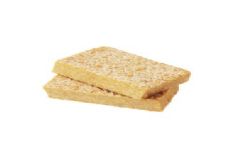|
Each Friday during Lent, the dailySpark will feature a different meat-free main dish. Whether you observe Lent or not, we can all benefit from learning about alternate, affordable proteins. It looks a bit like cereal, but it smells saltier and tastes more savory than sweet. It's a cheap, versatile and incredibly easy to use protein source that is sometimes hard to distinguish from ground meat. It's TVP. Textured Vegetable Protein. (TVP is in the front of the photo of soy products accompanying this article.) Let's demystify this vegetarian protein, which can be used in everything from chili and meatballs to tacos and shepherd's pie. What is TVP? TVP, or textured vegetable protein, is a byproduct of soybean oil production. After the oil is extracted from soybeans, soy flour remains. All the fat from the soybean remains in the oil, so only the defatted flour remains. The soy flour is then heated under pressure and then pressed through a revolving knife, which cuts the TVP. Most of the water evaporates because of the heat and pressure, leaving behind dehydrated flakes, granules and other bits, depending on the production process. TVP is mostly commonly seen in flake or granule form, but it can also be made into cutlets or other, larger shapes. Once rehydrated, the TVP has a spongy and fibrous texture. TVP is considered by many to be quite "processed," compared with other vegetarian protein that comes from "whole food" sources like beans or lentils. TVP is convenient when you want to make a vegetarian version of a dish but keep that "meat" texture. TVP is useful for people who are new to vegetarian cooking and want to adapt favorite recipes or for people who want to lighten up favorite meat recipes. It also can be used with ground beef, turkey, or lamb to stretch a dish. TVP is often used in prisons, schools, and other institutions in place of or alongside meat because of its affordability. A 10-ounce bag of TVP costs less than $3 and yields double that amount. In bulk bins, it goes for $2 or so a pound, which is much cheaper than an equal amount of ground beef. Nutrition: 1/4 cup flakes (dry, yields 1/2 c cooked) 80 calories 0 g fat 7 g carbs 4 g fiber 12 g protein 2 mg sodium How Do You Use It? TVP is often a "transition" food for vegetarians because it looks and feels so much like mince/ground meat. Swap it for meat in tacos, chili, soups, stews, meatloaf, meatballs, sloppy joes, spaghetti sauce, lasagna--pretty much any of your favorites. Season it as you would your meat, and you're good to go! TVP can either be rehydrated before or during cooking. For tacos, for example, add twice as much water as TVP, add some seasonings and let it simmer until tender, about 10 minutes. When making soup or chili, add the TVP straight to the pot and let it rehydrate while the rest of the ingredients cook. Find TVP recipes here. Have you ever eaten TVP? Would you? How do you cook it? |
Popular Entries
Related Entries
More From SparkPeople |






















